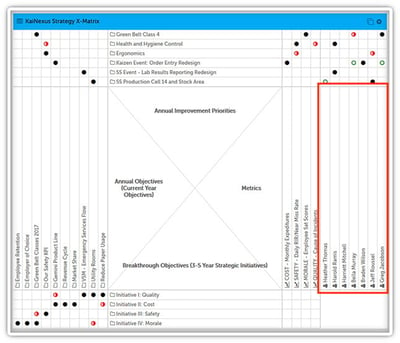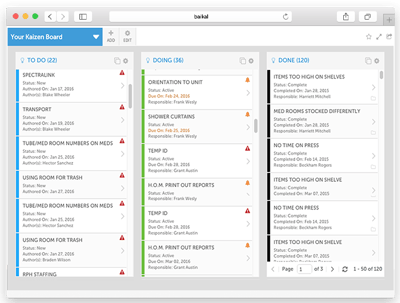 Hoshin Kanri is a Lean technique for strategic planning. The goal is to get everyone rowing in the same direction, at the same time, to achieve an organization’s breakthrough objectives in a 3-5 year timeframe. This is accomplished by aligning strategy, tactics, and daily operations.
Hoshin Kanri is a Lean technique for strategic planning. The goal is to get everyone rowing in the same direction, at the same time, to achieve an organization’s breakthrough objectives in a 3-5 year timeframe. This is accomplished by aligning strategy, tactics, and daily operations.
Developing a strategy and effectively executing it are two very different things. In order to be successful with such a long-term proposition, leaders need access to the right tools. Every organization that uses Hoshin planning does so in a unique way, but we’ve found four Hoshin planning tools that are frequently used by teams that get results.
Catchball
Catchball is a way to get many layers of the organization involved in strategic planning. Executives “toss” ideas for strategic objectives to the level of management below them. The managers then return the “ball” with their feedback and additional ideas. The goes back and forth until a consensus is reached. Department heads then repeat the process with their managers, and so on until the objectives have been cascaded through the organization. Everyone has clear goals that they helped to craft.
Catchball is relatively straightforward, but it does take practice and a culture that supports top-down and bottom-up decision making. Employees need to know that their input will be valued and that they are a crucial part of the process. It helps to have technology in place to streamline communications and make sure that no “balls” get dropped.
Catchball during Hoshin planning is an effective way to make sure that employees are given the opportunity to understand how they fit into the big picture and to help each person become more connected to the strategy.
X-Matrix
 It is common for organizations utilizing a formal Hoshin planning methodology to use a visualization tool called an "X-Matrix" to develop, explain, and help implement tactical and strategic plans. The tool helps with cross-functional coordination and breaks down silos.
It is common for organizations utilizing a formal Hoshin planning methodology to use a visualization tool called an "X-Matrix" to develop, explain, and help implement tactical and strategic plans. The tool helps with cross-functional coordination and breaks down silos.
There are five sections on an X-Matrix:
Breakthrough Objectives (Bottom Quadrant) - This quadrant enforces that practice by contains the objectives that are three to five years out. There are typically only have a few of them.
Annual Objectives (Left Quadrant) -This quadrant hosts shorter-term goals. These goals should all align with a breakthrough objective. The alignment between yearly objectives and breakthrough objectives should be indicated at the appropriate intersection.
Annual Improvement Opportunities and Priorities (Top Quadrant) - Here, the specific annual, short-term opportunities for improvement are listed. Each of the opportunities for improvement aligns with an annual objective, and that alignment should again be indicated at the appropriate junctions.
Metrics to measure, Targets to Improve (Right Quadrant) - Here users identify specific parameters that will be used to measure each of the short-term goals. Relationships are noted at the relevant intersections.
Teams and Ownership (Far Right Side) – In this section, the names of the people responsible for each metric, project, and objective are listed. Each person’s relationship to the other sections is identified with a mark at the correct junction.
The process of creating the X-matrix can be used to develop the strategy itself. Most leaders have a good idea of what the breakthrough goals ought to be, but the process of filling in the other sections of the tool can be very revealing. A well thought out X-matrix requires the involvement of multiple stakeholders, giving lots of people the opportunity to help determine how the team will navigate toward True North.
Strategy Deployment Boards
Strategy deployment boards are a visual management technique for tracking your KPIs. With digital boards, you can drill down into the details of any Project or Improvement to get updates, identify problems, and deploy resources. Multiple boards can be used, with the same strategic objectives following across the organization.
One valuable tool is a top-level strategic deployment Board that shows all of your True North goals and measures at the highest level. You can set up your boards to display your KPIs next to the corresponding improvements and projects. This approach creates a straight line between the work and the impact and makes it easier to identify the work that’s driving improvement.
 Huddle Boards for Daily Management
Huddle Boards for Daily Management
The biggest challenge of Hoshin planning is ensuring that the strategic objectives become central to everyday work. An excellent way to keep frontline staff connected with the strategic goals is to use Huddle Boards in your daily improvement management. This allows everyone to participate in improvement directly and contribute toward these high-level objectives.
Many organizations choose to display their digital huddle boards in common areas on large to ensure that everyone is connected and aware of progress. Look for solutions that allow your huddle board to be displayed anywhere and be updated from any device in real time. It should offer a detailed history of goals and progress with the ability to drill down into the details of any given project.
There are many other Hoshin planning tools that you can use, but these four will give you a good foundation and help your strategy deployment efforts succeed. Are there other Hoshin tools that you find essential? If so, let us know in the comments.

![[WEBINAR] Strategy Deployment Software Demo](https://no-cache.hubspot.com/cta/default/326641/67b72769-975a-48b1-b5d8-4ba0fe1f3b76.png)


Add a Comment